Apr 18, 2024
Apr 18, 2024
|
Chronology of Events |
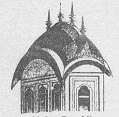 Curved Roof Form at Bengal |
Bengal was one of the foremost provincial Islamic outposts, beginning with A.D. 1193, when Muhammad Bakhtiyar Khilji extended Muslim rule right down to the ancient capital of Gaur. It is interesting to note that it was in the same year that Qutb-ud-Din Aibak established the Sultanate in Delhi. The reason for this rapid conquest, when closer places like Malwa took many years to subdue, was principally that the Ganges provided a great waterway to facilitate the movement, and so hordes of troop transports could navigate the river with ease all the way down to its estuary.
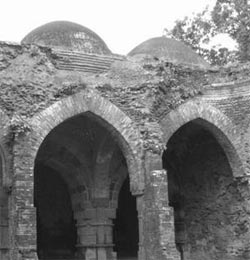 The lack of building stone in Bengal meant that most construction was carried out in brick, of which there was an abundant supply, and this meant that no building was possible using the usual column-beam construction so characteristic of early Islamic structures. Instead, right from the beginning, arches were used to span spaces and to support the weight above.
The lack of building stone in Bengal meant that most construction was carried out in brick, of which there was an abundant supply, and this meant that no building was possible using the usual column-beam construction so characteristic of early Islamic structures. Instead, right from the beginning, arches were used to span spaces and to support the weight above.
Brick thus lends Bengal architecture a style which is distinct, with its pointed arches and finishes so different from those in stone. Another remarkable feature which predominates is a curved roof form, no doubt derived from its bamboo predecessor. This curved roof was to prove very popular in north India in general, with later Rajput, Mughal and even Sikh architecture being influenced.
The harsh climate of Bengal also means that antiquities decay rapidly; indeed, according to Fergusson: “…the climate of Bengal is…singularly inimical to the preservation of architectural remains. If the roots of a tree of the fig kind once find a resting-place in any crevice of a building, its destruction is inevitable; and even without this, the luxuriant growth of the jungle hides the building so completely, that it is sometimes difficult to discover it – always to explore it.” 1
Of the pre-Islamic architecture, there are traces of Sena and Pala constructions in Gaur, which was long a Hindu capital city. Many fragments of Hindu architecture are still to be found, though not enough to accurately reconstruct the architectural style used. Their chief worth, however, is the influence they had on Islamic architecture in terms of short squat pillars used to support the superstructure above.
The architecture in Bengal can be further divided into two periods – the first from the 13th to 15th century when it was a provincial outpost of the Delhi Sultanate, and the second in the 15th and 16th centuries, when the Bengal Sultanate was established.
The first period is marked by construction influenced by Hindu remains, and the major traces of this are to found at Tribeni on the Hoogly river. The mosque and tomb of Jafar Khan Ghazi are adapted from the remains of a Hindu temple but have brick walls, as well as the earliest pointed arches in the province. In the nearby village of Chotta Pandua, the large ruined mosque is a similar mixture of arched and column-beam construction.
The Adina Masjid
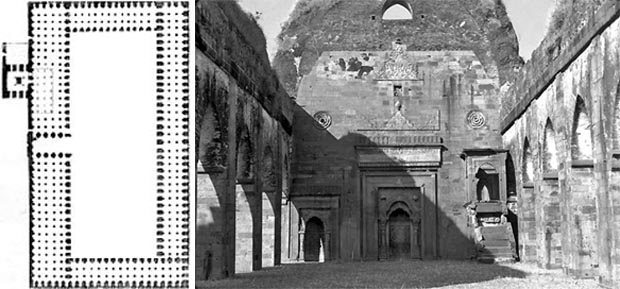
The Plan View of Mehrab
The Adina Masjid at Pandua, built by Sultan Sikander Shah to celebrate his victory over and independence from the Delhi Sultanate, is impressive in size but lacks in architectural significance. Measuring a huge 507 feet by 285 feet, the central court is surrounded by three and five aisled enclosures supported by pillars of basalt. When complete, the mosque had no less than 378 brick dome, as well as a huge central pointed vault over the liwan. Most of these have collapsed, including the central vault, and so the Adina Masjid today consists of little more than a pile of ruins, marked by arches and crumbling walls, the whole reminiscent of a Greek or Roman city in ruin.
Whatever be its architectural merits, the Adina mosque provided a valuable lesson in building in the inimical climate of Bengal, and with brick.
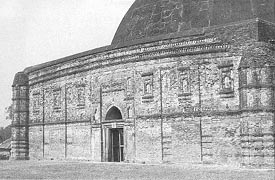 In the Eklakhi Tomb we see for the first time an Islamic curved roof inspired from the bamboo version, and the slight slope on the roof is a departure from traditional cubical construction and served to throw off rainwater.
In the Eklakhi Tomb we see for the first time an Islamic curved roof inspired from the bamboo version, and the slight slope on the roof is a departure from traditional cubical construction and served to throw off rainwater.
As befits an early example, the Eklakhi tomb remains rather tentative in plan as well as in execution. With strange proportions of the dome as well as the structure below, with a rather hesitant curved roof, the tomb nevertheless has stood the ravages of time, attesting to the efficacy of the curved roof as well as its stout construction.
The Bengal Mosque
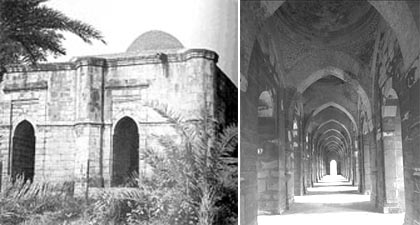 Once again, after the lessons of the Adina Mosque, the climate of Bengal proved to be a decisive factor in determining the plan. It was evident that a large open courtyard was useless in the long monsoons in Bengal. And so the courtyard was replaced by an enclosed hall. Once this principle had been established, a large number of mosques came up in and around the city of Gaur. Notable among these are the Chotta Sona and Bara Sona masjids. Both apparently had gilt applied to their curved roofs, which gives them their name – literally, ‘Golden Mosques’.
Once again, after the lessons of the Adina Mosque, the climate of Bengal proved to be a decisive factor in determining the plan. It was evident that a large open courtyard was useless in the long monsoons in Bengal. And so the courtyard was replaced by an enclosed hall. Once this principle had been established, a large number of mosques came up in and around the city of Gaur. Notable among these are the Chotta Sona and Bara Sona masjids. Both apparently had gilt applied to their curved roofs, which gives them their name – literally, ‘Golden Mosques’.
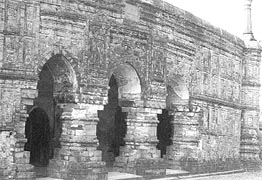 One of the last of the mosque examples in the Qadam Rasul mosque, a rather smaller example with stocky basalt pillars supporting the arches above.
One of the last of the mosque examples in the Qadam Rasul mosque, a rather smaller example with stocky basalt pillars supporting the arches above.
The mosque, according to Satish Grover, is ‘flaccid and formless’, but possesses nevertheless beauty in its robust proportions, in the aggressive outward thrust of the column bases, and indeed in the columns themselves which are divided into tiers, emphasizing their low height and posture.
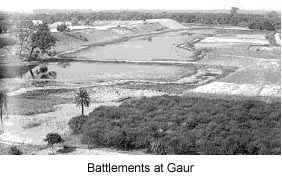 The Dakhil Darwaza, marking the entrance to the remodeled city of Gaur with its broad thoroughfares, as well as the Feroza Minar or ‘Blue Tower’ marked some of the finest late examples of the Bengal style before the Ilyas Shahi dynasty succumbed to an Abyssinian mercenary in 1489.
The Dakhil Darwaza, marking the entrance to the remodeled city of Gaur with its broad thoroughfares, as well as the Feroza Minar or ‘Blue Tower’ marked some of the finest late examples of the Bengal style before the Ilyas Shahi dynasty succumbed to an Abyssinian mercenary in 1489.
11-Aug-2002
More by : Ashish Nangia